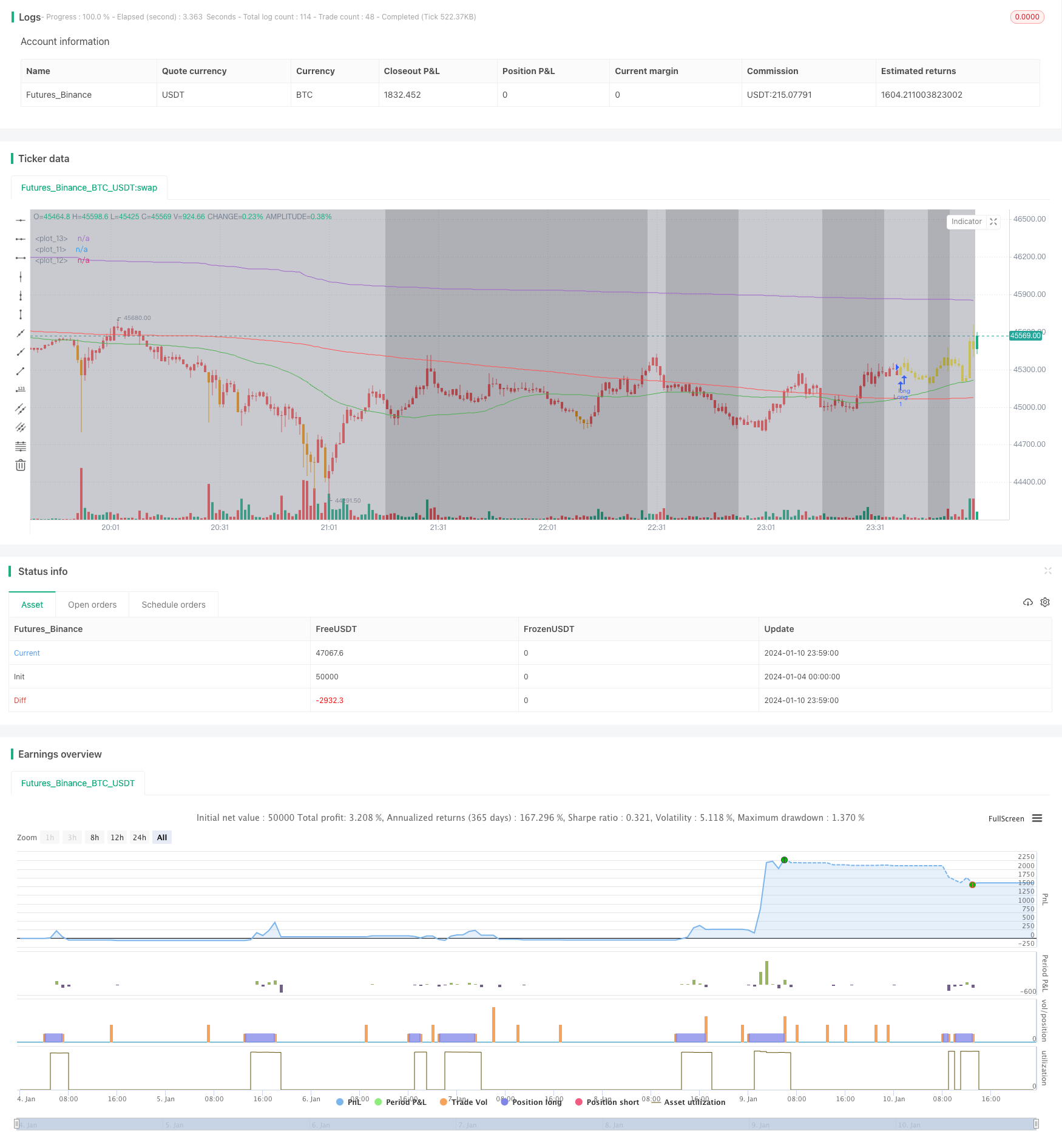
概述
本策略利用简单移动平均线组合双均线策略,辅以ATR波动率指标判断市场波动率。当短周期均线上穿长周期均线时判断为多头市场,做多入场。当短周期均线下穿长周期均线时判断为空头市场,做空入场。同时结合成交量加权平均价VWAP判定均线信号的可靠性。此外,结合RSI指标避免反转。用ATR波动率指标判断市场波动率,从而选择较低波动率时段交易。
策略原理
核心部分是双均线策略。双均线策略一般选取短期均线和长期均线,如50日均线和200日均线。当短期均线上穿长期均线时产生买入信号。当短期均线下穿长期均线时产生卖出信号。双均线策略判断市场长短期趋势的变化,通过均线的突破来捕捉趋势的转折点。
本策略中选取了50日均线作为短周期均线,200日均线作为长周期均线。结合成交量加权平均价VWAP判断均线信号的可靠性。即只有当均线信号和VWAP同向时才入场。这样可以过滤掉一些假信号。
另外加入RSI指标避免买入过头和卖出过头。RSI高于70时避免买入,RSI低于30时避免卖出。
最后通过ATR平均波动幅度指标判断市场的波动率和风险水平。ATR值大于1.18时定义为高波动,这时通过改变背景色提示风险较高,可以暂时避开交易,等待波动率降低后的时机。
优势分析
本策略优势主要体现在三个方面:
双均线捕捉市场中长期趋势的转折点,利用趋势交易获得较大利润。
结合VWAP过滤假信号,提高信号的可靠性。
引入RSI指标避免逆市交易,可以减少亏损。
应用ATR波动率指标判断市场风险状况,避开高波动时段,可以降低损失。
各种指标组合使用简单明了,容易理解实现,适合量化交易入门。
风险分析
本策略也存在一些风险:
1.双均线产生信号时,价格可能已经发生较大变动,存在被套利的风险。解决方法是降低均线周期,加快指标反应速度。
2.VWAP可能出现误差,导致过滤掉正确的交易信号。解决方法是辅以其他指标确认。
3.在趋势末期,RSI可能长时间处于超买超卖区域,导致错过趋势反转点。解决方法是结合其他指标确认,如MACD。
4.ATR判断市场波动时可能存在滞后。解决方法是结合最高价、最低价等判断市场波动。
5.收益可能达不到预期,需要适当调整参数。
优化方向
本策略还存在很大优化空间:
1.测试更多均线组合,寻找最佳参数。
2.加入更多辅助指标过滤信号。比如MACD,KDJ等。
3.优化止损止盈参数,降低亏损,提高盈利。
4.评估强势股和弱势股的交易策略差异性,进行分类建模。
5.结合机器学习算法如RNN等,实现参数的自动优化和策略评估。
6.开发自动交易系统,连接 실盘进行回测验 .
总结
本策略整体来说是一个较为简单的趋势追踪策略。核心运用双均线判断长短期趋势。结合VWAP和RSI对信号进行处理,应用ATR评估风险。策略思路简单,容易理解操作。通过一定优化空间,可以获得较好的收益。作为量化交易入门选择,是非常适合的。
/*backtest
start: 2024-01-04 00:00:00
end: 2024-01-11 00:00:00
period: 1m
basePeriod: 1m
exchanges: [{"eid":"Futures_Binance","currency":"BTC_USDT"}]
*/
//@version=5
strategy("Simple Moving Averages", overlay=true)
sma50 = ta.sma(close, 50)
sma200 = ta.sma(close, 200)
vwap = ta.vwap(close)
rsi = ta.rsi(close, 14)
[diPlus, diMinus, adx_val] = ta.dmi(14, 14)
atr_val = ta.atr(14)
plot(sma50, color=color.new(color.green, 0))
plot(sma200, color=color.new(color.red, 0))
plot(vwap)
longCondition = ta.crossover(sma50, sma200) and vwap > close
shortCondition = ta.crossunder(sma50, sma200) and vwap < close
if (longCondition)
strategy.entry("Long", strategy.long)
if (shortCondition)
strategy.entry("Short", strategy.short)
barcolor = sma50 > sma200 ? (vwap < close ? (rsi < 70 ? color.green : color.blue) : color.yellow) : (sma50 < sma200 ? (vwap > close ? (rsi > 30 ? color.red : color.orange) : color.yellow) : na)
barcolor(barcolor)
bgcolor(adx_val > 25 and atr_val > 1.18 ? color.new(color.gray, 50) : color.new(color.black, 50), transp=90)
// ADX and ATR Label Box
// label.new(bar_index, high, "ADX: " + str.tostring(adx_val, "#.##") + "\nATR: " + str.tostring(atr_val, "#.##"), color=color.new(color.white, 0), textcolor=color.new(color.black, 0), style=label.style_labeldown, yloc=yloc.price, xloc=xloc.bar_index, size=size.small, textalign=text.align_left)
// Exit conditions (optional)
strategy.close("Long", when = ta.crossunder(sma50, sma200))
strategy.close("Short", when = ta.crossover(sma50, sma200))
// Take Profit and Stop Loss
takeProfitPercentage = 5
stopLossPercentage = 3
strategy.exit("Take Profit / Stop Loss", "Long", profit = takeProfitPercentage, loss = stopLossPercentage)
strategy.exit("Take Profit / Stop Loss", "Short", profit = takeProfitPercentage, loss = stopLossPercentage)